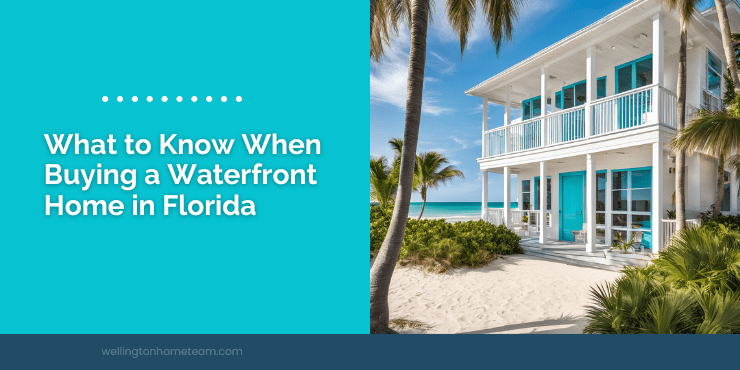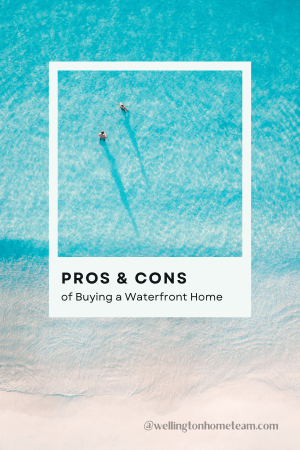What to Know Before Buying a Waterfront Home in South Florida
As a real estate agent specializing in South Florida properties, I often get questions about buying waterfront homes. It’s easy to see why—the idea of living on the water is a dream for many. But there’s a lot to consider before committing. Let me walk you through what you need to know to make the right choice, whether you’re eyeing the ocean, a lake, or a canal.

Types of Waterfront Homes
The term “waterfront home” can mean many different things, especially in South Florida. Unlike some areas of the country that may only have lakefront properties, South Florida offers a variety of waterfront options. Here’s an overview of the types of waterfront homes you’ll find in South Florida:
- Oceanfront Homes: These homes are the epitome of waterfront living, offering breathtaking ocean views and the refreshing scent of the salty breeze. Some may even include private beach access.
- Intracoastal Waterway Homes: Perfect for boating enthusiasts, these homes are located on the Intracoastal Waterway—a network of canals and inlets that connect to the ocean. You’ll often find private docks and calmer waters here as well.
- Lakefront Homes: South Florida’s natural and man-made lakes offer a serene setting and depending on the size may offer activities like kayaking or fishing.
- Canal Homes: Canals in the area are typically non-navigable, serving primarily as drainage or irrigation channels to manage water levels in the region’s flat, low-lying terrain. Unlike navigable canals, these waterways are too shallow or narrow for boats. They commonly run through residential neighborhoods, agricultural lands, and natural landscapes.
- Man-Made Lakefront Homes: Found in many planned communities, these homes provide a controlled environment with beautiful water views and fewer risks like flooding or erosion.
What’s More Important: Location or Waterfront Type?
When buying a waterfront home in South Florida, deciding whether location or waterfront type is more important depends on your specific needs and lifestyle. Location will determine the types of waterfront options available, as some areas only offer specific types, such as oceanfront, lakefront, or canal. Similarly, selecting a specific waterfront type will limit the areas or neighborhoods you can choose from.
For instance, if being close to work, schools, or amenities is your main priority, you may need to be flexible with the type of waterfront. On the other hand, if you’re set on having oceanfront property, your options will be limited to certain coastal neighborhoods.
It’s all about finding the right balance between location and waterfront type based on what matters most to you.
Thinking about buying a waterfront home in Florida? If so there are several things you should know and consider before jumping in with both feet. #realestate #homebuyingPros of Buying a Waterfront Home
Let’s talk about why waterfront homes are so desirable. Here are some of the top reasons my clients fall in love with them:
- Stunning Views: There’s nothing like waking up to a water view. It adds a sense of peace and beauty to your daily life.
- Water Activities: If you love boating, fishing, paddleboarding, or just lounging by the water, some waterfront homes make it convenient.
- Privacy: Many waterfront homes are tucked away in less crowded areas, offering a sense of exclusivity.
- Investment Potential: Waterfront properties tend to hold their value well and often appreciate faster than non-waterfront homes.
- Vacation Rental Income: If you’re not living there full-time, your waterfront home could generate significant income as a rental.
Cons of Buying a Waterfront Home
Of course, no property is perfect, and waterfront homes come with their share of challenges. Here’s what you need to consider:
 Higher Costs: These homes often come with steeper price tags, property taxes, and insurance premiums.
Higher Costs: These homes often come with steeper price tags, property taxes, and insurance premiums.- Maintenance: Saltwater, humidity, and exposure to the elements can take a toll. You’ll need to stay on top of maintenance for things like seawalls, docks, and the home itself.
- Flood Risk: Living near water means a higher risk of flooding, so flood insurance is a must.
- Environmental Regulations: These properties are subject to stricter laws, which can limit what you can build or modify.
- Privacy Concerns: Depending on the location, you might deal with foot or boat traffic near your property.
- Seawalls and Docks: These can be expensive to repair or replace, so it’s important to know their condition upfront.
- Utilities: Some waterfront properties may require expensive specialized systems for water, sewage, or electricity.
Questions to Consider When Buying a Waterfront Home
- What is the water’s depth and clarity?
Different waterfront types vary in water depth and clarity. For example, oceanfront properties may have deeper waters but may not be ideal for certain activities like swimming, while lakes and canals might be more suitable for fishing or kayaking. - How prone is the area to flooding or storms?
Oceanfront and intracoastal properties may be more vulnerable to hurricanes and storm surges, while lakes and canals could be affected by heavy rains or flooding from upstream. - What recreational activities are allowed?
The location and waterfront type will determine what recreational activities are allowed, but the most common options include boating, fishing, kayaking, swimming, and paddleboarding. - How accessible is the waterfront for recreational activities?
Oceanfront homes may offer direct beach access, but certain canals and lakes may provide opportunities for boating, fishing, and other water activities. - What are the property setbacks from the water?
Zoning laws and regulations vary by location. Oceanfront homes typically have stricter setbacks due to coastal regulations, while lakefront and canal properties may have more flexibility in terms of how close your home can be. - What is the level of privacy?
Oceanfront homes often have the most privacy due to their location, but intracoastal properties, especially in more developed areas, may have more foot traffic and boat activity. Canals and man-made lakes tend to offer a mix of privacy depending on the neighborhood and what’s on the other side of the canal or lake. - What is the local wildlife like?
Oceanfront and intracoastal properties may have sea life, while lakefront properties could have freshwater fish and birds. Man-made lakes and canals may feature different types of flora and fauna, including fish, turtles, and alligators in certain areas. Alligators are more common in freshwater environments like lakes and canals, particularly in Florida, so it’s something to keep in mind. - Are there any current or potential environmental concerns?
Oceanfront and intracoastal properties could face erosion and rising sea levels, while lakes and canals may have concerns like algae blooms or pollution. Check for any ongoing environmental issues that could affect the property value or your lifestyle. - What maintenance will be required for the waterfront?
Oceanfront properties may need more maintenance due to saltwater exposure, while man-made lakes or canals could require little to no maintenance. - What are the views like?
Oceanfront properties typically offer expansive, unobstructed views, while other types of waterfront properties may be surrounded by structures, homes, or trees. - How much boat traffic or noise is typical?
Oceanfront and intracoastal properties may experience high boat traffic, unlike other water types. - What is the availability of amenities like docks or piers?
If you’re interested in having a boat, check whether the property has a dock or pier. - What are the zoning laws and regulations for construction?
Zoning regulations can vary greatly between different types of waterfront properties. Oceanfront and intracoastal homes may have more stringent building codes due to coastal regulations, while lakefront and canal properties may offer more freedom. - What types of inspections should you conduct?
It’s important to conduct a general home inspection to assess the condition of the property, as well as specialized inspections for the foundation and seawall if applicable. Additionally, a termite inspection is recommended, along with a flood risk assessment and a dock inspection if the property has one. A mold inspection is also advised, as waterfront homes can be prone to moisture-related issues.
These questions will help you make a more informed and educated decision when buying a waterfront home.
How I Can Help You Find Your Dream Waterfront Home
As your real estate agent, my goal is to make the process of buying a waterfront home as smooth as possible. I’ll guide you through every step, from identifying the right type of property to navigating local regulations and negotiating the best deal. My local expertise ensures you’ll find a home that fits your lifestyle and budget.
Let’s start the journey to your dream waterfront home together. Whether you’re dreaming of oceanfront luxury, a quiet lake retreat, or a boater’s haven, I’m here to help you every step of the way!
Please consider spreading the word and sharing; What to Know Before Buying a Waterfront Home in Florida
Thinking about buying a waterfront home in Florida? If so there are several things you should know and consider before jumping in with both feet. #realestate #homebuyingAbout the Author
Top Wellington Realtor, Michelle Gibson, wrote: “What to Know Before Buying a Waterfront Home in Florida”
Michelle has been specializing in residential real estate since 2001 throughout Wellington Florida and the surrounding area. Whether you’re looking to buy, sell or rent she will guide you through the entire real estate transaction. If you’re ready to put Michelle’s knowledge and expertise to work for you call or e-mail her today.
Areas of service include Wellington, Lake Worth, Royal Palm Beach, Boynton Beach, West Palm Beach, Loxahatchee, Greenacres, and more.

 Michelle Gibson of the Hansen Real Estate Group Inc is a full-time REALTOR who has been specializing in Wellington, Florida real estate since 2001. This veteran of the real estate industry has expertise in technology, marketing, and social media.
Michelle Gibson of the Hansen Real Estate Group Inc is a full-time REALTOR who has been specializing in Wellington, Florida real estate since 2001. This veteran of the real estate industry has expertise in technology, marketing, and social media.